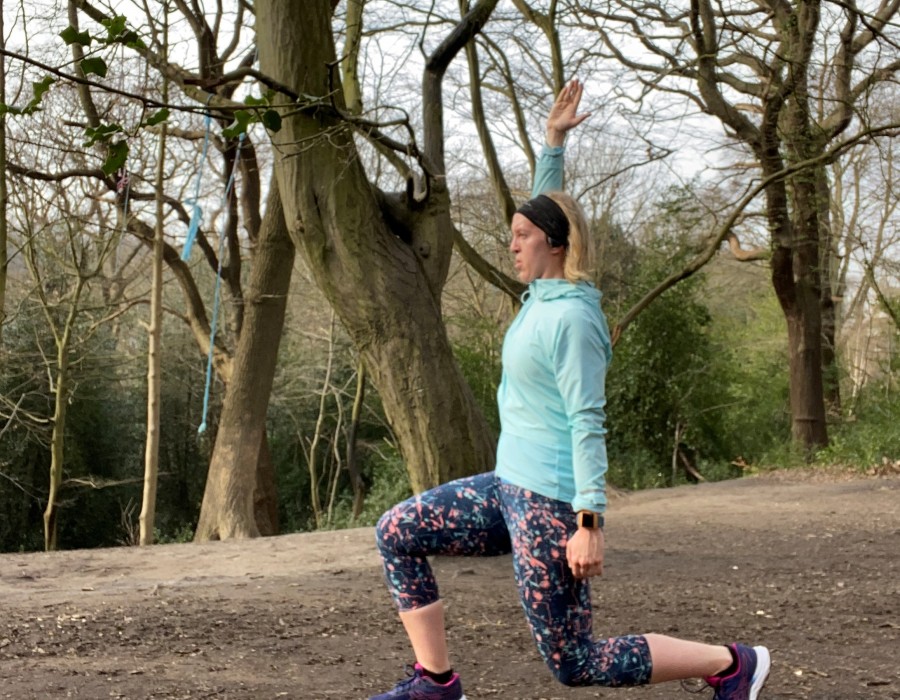Fitness and Performance
Training for an ultramarathon with Rebecca

Training for an ultramarathon with Rebecca | part 1
Bodyset RunFit Specialist Rebecca, is taking on an ultramarathon this summer. That’s 100 kilometres of non-stop running in a single day. Having already run 3 marathons, Rebecca is familiar with some of the challenges that accompany long-distance training. However, getting ready for an ultramarathon comes with it’s own set of hurdles. But lots of fun along the way! Here’s how Rebecca is getting on so far…
In October 2020 I completed my third marathon with the virtual Virgin Money London Marathon. Despite running on my own due to Covid safety measures, it was an amazing day. We were sent the numbered bibs beforehand so I was able to wave to other runners on my route around London. We managed to create our own charged atmosphere and together we set a Guinness World Record for the most users to run a remote marathon in 24 hours.
I also achieved a personal best by completing the London Marathon in less than 4 hours for the first time ever. Feeling over the moon, a few of my running friends and I decided to take things one step further by signing up to the Race to the Stones 2021 Ultramarathon. I bit the bullet, signed up, and here I am on my journey so far.
Race to the Stones Ultramarathon
Race to the Stones takes place over 10th-11th July 2021. It’s a 100 km run that starts in Lewknor, Oxfordshire and finishes at Avebury Henge and Stone circles in Wiltshire. You can sign up to complete it over 2 days with camping or complete it in one go. It’s a beautiful route with lots of historic sites to see along the way. I signed up for the non-stop race in the 14-18 hours start group because I know I’ll need to walk some parts of it!
Since signing up I’ve gone through a wide range of emotions. From excitement to fear and from determination to disbelief, but mostly there has been a lot of nervous excitement. A challenge like this requires preparation, sacrifices and some lifestyle changes in order to complete it. So far, most things have gone well, but I know it will get harder further down the line.
Prepping and planning
As I have already completed 3 marathons, I have a good level of fitness to get started with. Through November and December 2020 I was running 5-10 kilometres, around 2-3 times per week. I was also doing strength training and/or HIIT workouts. In the first week of January, I started researching training programmes and planning the coming months. At this point I didn’t need to be precise, but wanted to have a general idea of how I ought to be training at each stage of the journey. My plan is to complete a half marathon programme first, so that I have a short-term goal to focus on and don’t feel overwhelmed by the longer run ahead. This means doing shorter runs and slowly increasing the mileage of one of those runs per week.
A slow and steady increase in mileage over the weeks is much more manageable and preferable for avoiding injury. Deciding where to start and how many runs per week, all depends on what your baseline is. If you’re completely new to running I would advise that you start a 6-month programme with a plan to walk large chunks of the route on race day. Run 3-4 times a week and incorporate walking into them. If you’re used to running, then start at your baseline and slowly build from there. Initially it’s all about getting used to being on your feet and doing something most days, even if it’s a long walk. This way your muscles, joints and tendons have time to adapt to the loading. As I get into the higher mileages, I will start to incorporate walking into my training too.
Cross-training
Running isn’t the only sport I enjoy. I do a wide variety of strength training, HIIT and cycling. I enjoy other sports and the variety helps reduce the risk of injury when I increase my running mileage. After my October 2020 London Marathon I reduced my running for the rest of that month to let my body rest up. When I started running again in November, I got some mild left heel and low Achilles pains. This is very common when you have been loading the foot with a lot of miles and suddenly stop.
To help myself, I started doing more single-legged exercises to strengthen the ankle. I also added single-legged heel raises to my routine 2-3 times per week to slowly get the Achilles to tolerate more load. I continued running but at a slower pace, covering shorter distances until I felt free from pain. By January 2021 the pain was gone, but I have continued with the strengthening exercises to reduce the risk of pain returning.
Listening to your body
If you’re experiencing any kind of pain then it’s important to get on top of it straight away. An injury left unattended will often lead to further complications and perhaps even take you out of the running for race day entirely. Take a look at your training programme to identity whether you’ve seen any spikes or dips in distance and training intensity. Has this influenced your pain?
Alternatively, if you’re only form of exercise is running then I would strongly recommend that you find something else to do alongside it. It can be strength training, Pilates, yoga, cycling or swimming, among other fun sports. If making these adjustments doesn’t help, then do book in to see one of our RunFit Specialists. They can help you identify the cause of the pain, prevent further injury and even help you improve your running performance.
My running journey continues…
Whilst I’m still feeling that nervous excitement, I am looking forward to the journey ahead. It is completely normal to have days where you don’t want to go out and exercise, and other days where you feel on top of the world. So don’t forget to cut yourself some slack! Missing one run every now and again is not the end of the world so just try to get out for a short walk or do some stretching instead.
I look forward to sharing more of my journey with you so stay tuned for part 2 of my ultramarathon-training journal soon!
